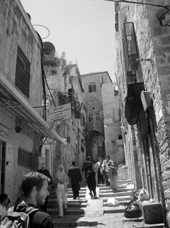Yesterday, about 20 people from my program went to the world's oldest city, Jericho. An oasis town on the banks of the Jordan river, Jericho emerges from the Judean desert and provides, unfortunately, very little relief from the intense heat.
We were accompanied by a Professor of Archeology from the university here, who took us to a number of important archeological sites in different towns in the immediate area. Honestly, I can't tell you many details - Palestine is so old that it has accumulated so many diverse and important "periods" - something that makes it very hard to contextualize. Stone Age... Iron Age... Canaanite (the original "Palestinians")... Israelite... Roman... Byzantine... Mamluke... Ottoman... its a dizzying array that leaves me confused yet still impressed.
Our trip took us through Taybeh - home of Taybeh Beer - and then to the first Israel checkpoint I've crossed within the West Bank. It's there to ensure that only Jews drive on the specially constructed super-highways that bisect the West Bank in three places and link all the illegal settlements. In North America the debate over the use of the word "apartheid" in relation to this conflict used to make me roll my eyes. Now that I've seen it myself - the crappy highways that we ride on that passes under the perfectly paved one reserved only for a particular ethnic group - I don't know what else it could be called. And keep in mind... this is in the middle, well WITHIN the West Bank. But I digress... The exchange with the 18 year old soldier was as unpleasant as ever, and we were back on our way.
The Judean desert is hot as hell. I drank more than 3 liters of water and the fact that I've been sick for the past couple of days didn't help things. We descended along winding and narrow roads at tremendous speed towards the lowest point on earth. Through the valleys that figure prominently in the Bible ("yea though I walk through the Valley of the Shadow of Death" from psalms 13, Wadi Qelt is just around the corner) the landscape is barren and pocked with caves that, like Qumran not far to the south, could easily contain lost parchment.
We see Tel al-Sultan, ruins of a city that is 9000 years old. 9000 years old - the earth has consumed the 8m walls and I have trouble visualizing the surrounding area. Oh well, on to the next. Hishams Palace was far more recent - 1000 years old maybe? And its columns remain visible, along with its rooms with world famous mosaic floors (actually the most stunning thing about the day!). But its too hot. I almost throw up leaving an on-site mosaic research lab. I head back to the bus and while I'm there, my group that's behind me decides to forego the planned pool swimming (an entertainment here that is both costly and gender-segregated and thus not as popular as it easily could be). I'm happy as all I want to do is get home and have a cold shower and a nap.
There is something to be said about civilization that builds itself up and over thousands of years is consumed, in turn, by the earth. I saw it in Tikal in Guatemala... the Mayan pyramids that remain visible only in form, buried under the jungle. I'm going to Petra this weekend and I'm wondering if I'll see something different.
Friday, July 14, 2006
Subscribe to:
Post Comments (Atom)

No comments:
Post a Comment